Elan has been relatively quiet in the ski touring world over the past few years. There was the lightweight Ibex line, highly regarded by some, but maybe not particularly interesting to this reviewer. On the other end of the spectrum, the Ripstick line of freeride/on-piste skis were light enough to consider for touring but on the heavy side for sure. Enter the Ripstick Tour line—lightweight, borrowing design cues from the popular Ripstick line; my interest was piqued.
The Ripstick Tour 104 (RST 104) is Glen Plake’s signature ski. For anyone that needs a reminder (or introduction) to the chops Glen brings to the table:
The RST 104 retains some hallmark Ripstick features, such as Amphibio—asymmetrical camber/rocker profiles on the inside/outside edges and Tubelite carbon tubes—lengthwise carbon tubes set into the core to tune lengthwise flex. In Plake’s words, he wanted his touring ski to ski “easy” and handle all the surfaces you may encounter throughout a long ski tour “easily.”
Design Highlights
The RST 104 has a few specs that intrigue me, some of which are quite different from the other models in the Ripstick and Ripstick Tour line. First, it has a 23m turn radius in the 180cm length. I often enjoy a long (>20m) turn radius on touring skis as it makes them feel less hooky or grabby in firm snow or breakable crust; plus, making big sweeping turns are super fun. Second, they have a progressive mount point at—6 cm from center. I’m no center mounting freestyle skier, but I have often come to prefer more progressive mount points in the -8cm to -5cm range as it plays well with the more centered stance demanded by lighter boots, as well as feeling a bit more maneuverable in tight spots.

Square tip, centered mount, and straight sidecut are standout features – once you look past the brightness.
From the inside out, the Tubelight wood core is stiffened by a single carbon rod visible along the topsheet. A “carbon bridge” wraps the core, along with a 360-degree sidewall. A 3.6 x 9mm drill bit is recommended, so there is no metal reinforcement in the mounting area. The edges are on the thin side of normal and run nearly to the tip but stop a few cm short. The tip is quite square and has a small detent for Elan’s proprietary skin attachment; a standard wire loop may be a bit finicky here. In the tail, the ABS sidewall extends into a nice tail protector that comes pre-notched to hold a skin tail clip—good stuff.
The 23m radius is among the longest in the mid-100s touring ski class. The straight sidecut is paired with minimal taper to make for a ski that looks, and skis, quite straight. The stiffness profile is interesting—the tip is soft, underfoot they are medium-stiff, and the tail is medium-stiff. More on the soft tip later, but this is a key attribute to keeping the Tour 104 forgiving.
Turn the skis on their side, and things get interesting. Due to the Amphibio design, the rocker lines change depending on which edge you are looking at.
Overall, the RST 104 has an interesting mix of rather ordinary attributes, with a few curve balls thrown in -such as the long radius, progressive mount point, and relatively soft tip. I wasn’t sure what I was getting myself into here: a demanding bottom feeder that isn’t much fun but eats up variable snow and steeps or a playful daily driver that is easy to get along with.
I received a pair of the RST 104s in the 180cm length, mounted with ATK Raider 12 Rental bindings and Elan branded Contour hybrid skins. While the bindings are much heavier than my favored Ski Trab Gara Titan, they are by far the best rental/demo touring binding I’ve used. They have a solid and secure feeling tool-less heel and toe adjustment, in addition to all the other perks of an ATK Raider. They came from Elan mounted -2cm from recommended, but with the demo bindings, I could play with the mount point a bit. I mostly skied them at -2 or on the recommended line.
I used both the Tecnica Zero G Tour Pro and Tecnica Zero G Peak during testing.
Field Testing the Ripstick Tour 104
Powder/soft snow
A lot of the soft snow character of the RST 104 relates back to the soft tip— it does an excellent job planing to the top of most soft snow. The RSTs felt energetic and bouncy in soft snow. I would put their float/planing capability above the Blizzard Zero G 105, on par with the Nordica Enforcer Unlimited 104, and not quite as good as the OGSO Schwarztor 100. While it’s easy to write off good soft snow performance, most skis are pretty fun in powder; the RST 104 was uniquely quick and energetic in these conditions. After some powder skiing, I don’t think I would have guessed the 23m radius—they felt turny and easy. I never felt like they wanted to lock into a long radius turn, and run away from me.
Crud/Tracked/Variable Snow
The same people who will tell you any ski is fun in powder usually finish by saying something about bad snow is where you really learn about a ski. By that metric, the RST 104 fell a bit flat. I remember one day in particular that I didn’t go skiing till late afternoon, a sunny day after some new snow. Unfortunately, a breakable crust had formed on the now shady south faces, and I struggled mightily. Unlike in powder, where I didn’t feel the full 23m radius, I felt all 23m and more in the breakable crust. It felt a little like the tip wanted to rise out of the crust rather than slice/break through. Inevitably, it would break through as I pressured the bottom of a turn, and the skis would catch the bottom and want to run away in a 23m turn.
The RST 104 fared a bit better in tracked or 3d snow, although the flex pattern still seemed to work against itself in some ways here. A stiff ski can often plow through variable snow in a way that is at least predictable. Meanwhile, a softer ski can deflect, and the good ones rely on some dampness and suspension to ride variable snow well. The soft tip of the RST 104 deflected like a soft ski, then seemed to “bully” around the stiffer middle and back half of the ski. While it’s certainly tricky to make a 1500g ski work well in challenging conditions, the RST 104 was more challenging than most.
Firm Snow/Steeps
For firm snow and steeper runs, I have a strong preference for skis with a long turning radius and a flat tail. The RST 104 certainly checks the long radius box here, and looking at the tail, it seems like it would quickly engage once the ski is on edge. In practice, they are adequate in steep or firm conditions. Thanks to the long radius and stiff tail, they were consistent and predictable.
Given the various carbon bits and full sidewalls, I expected good torsional rigidity and edge hold. I was a bit underwhelmed here. They weren’t noodles, but they felt a bit lacking in edge hold relative to my favorite skis in the steeps, Blizzard Zero G 105s.
Resort Skiing/Groomers
Often, while on piste, especially on touring skis/boots/bindings, I prefer a tighter turning radius, mostly as a speed control mechanism. I was surprised at how little I minded the 23m radius here. Similar to the feel of powder skiing, the RST 104 felt energetic and easygoing on piste. The tails felt quite loose and easy to break free or pivot as needed. When the going got firm, the lack of torsional rigidity was a bit limiting for carving hard, but that’s not what the RST 104 is all about. Relative to any other cambered, long-radius ski I’ve used, the RST 104 was quicker and easier to carve various turn shapes – don’t let the long radius scare you off.
Some additional thoughts
There is a lot to unpack here – the RST 104 is certainly a unique ski, and as I finish writing my thoughts on performance in various conditions, there are a few things I feel like I’m missing.
Mount point
With a recommended mount point of -6cm, the RST 104 is quite progressive in the world of non-twin-tip touring skis. Many similar skis have a mount point in the -7cm to -10cm realm. In practice, this makes the RST 104 respond better to a more centered weight distribution and perhaps better suited to touring boots that are generally less progressive flexing and more upright than alpine boots.
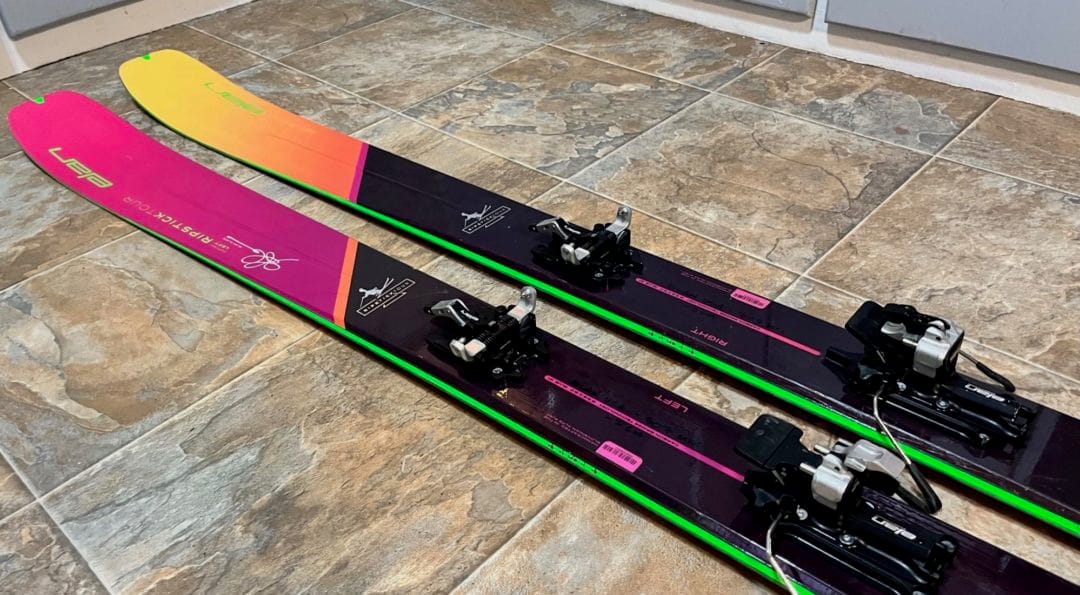
Make sure your Ripsticks are on the right foot! Note that the brakes pushing the rear of the ski up downplays the tip rocker a bit here.
Elan sent the skis mounted at -2cm from recommended (net -8cm), putting things in line with other skis in the class. At -2cm, it felt more necessary to drive the tips to turn the skis – the 23m radius felt more “present” in this configuration. Meanwhile, moving forward to the recommended point is where I best felt the energetic and turny sensations that I really enjoyed. Often, the designers know best when it comes to mount point, and while they feel more like other skis when mounted further back, it seems to defeat the point of a unique ski to try to make it more like the others.
Amphibio
While Elan’s Amphibio technology features heavily in marketing content, it is notably absent in my on-snow descriptions. That’s because in my on-snow experience, it just wasn’t notable or even noticeable. This isn’t to say it isn’t good technology or that it doesn’t make a difference, but it is subtle. Among the many unique attributes the RST 104 possesses, the Amphibio was most notable because I had to remember to put my skis on the right foot.
Conclusion
I’ll start by answering the question I posed in the design highlights section. The RST 104 is certainly the latter, a playful daily driver that was (mostly) easy to get along with. By combining a modern, progressive shape, rocker, and mount point with a proper touring ski weight and skinning-friendly flat tail, the RST 104 has caused quite a buzz from a variety of skiers. While it certainly has its weaknesses in poor conditions, it is a really fun ski in most of the conditions that most ski tourists seek when they venture out. I reckon the RST 104 will serve as a gateway drug for many skiers getting into more progressive touring ski designs that play nicely with light and more upright boots that are gaining popularity all the time.
Elan Ripstick Tour 104, 180cm Specs
Available lengths (cm): 166, 173, 180, 187
Weight (180cm): claimed – 1550g (Verified at 1989g with ATK Demo Binding 450g claimed so…. 1539g)
Side cut: 128-104-122
Turn radius: 19.0m [166], 21.5m [173], 23.0m [180], 25.4m [187]
Core: Tubelite woodcore (paulownia/poplar core with a carbon fiber rod reinforcement)
Build Comments: 360* Sidewall, carbon and fiberglass reinforcements
Shape: Tip and Tail Rocker, Camber underfoot, Amphibio Profile
Cosmetics: Glen Plake’s signature skis, complete with the color palette of his peak era
Similar Models: Faction La Machine Mega, Line Vision 108
Price: $799.95

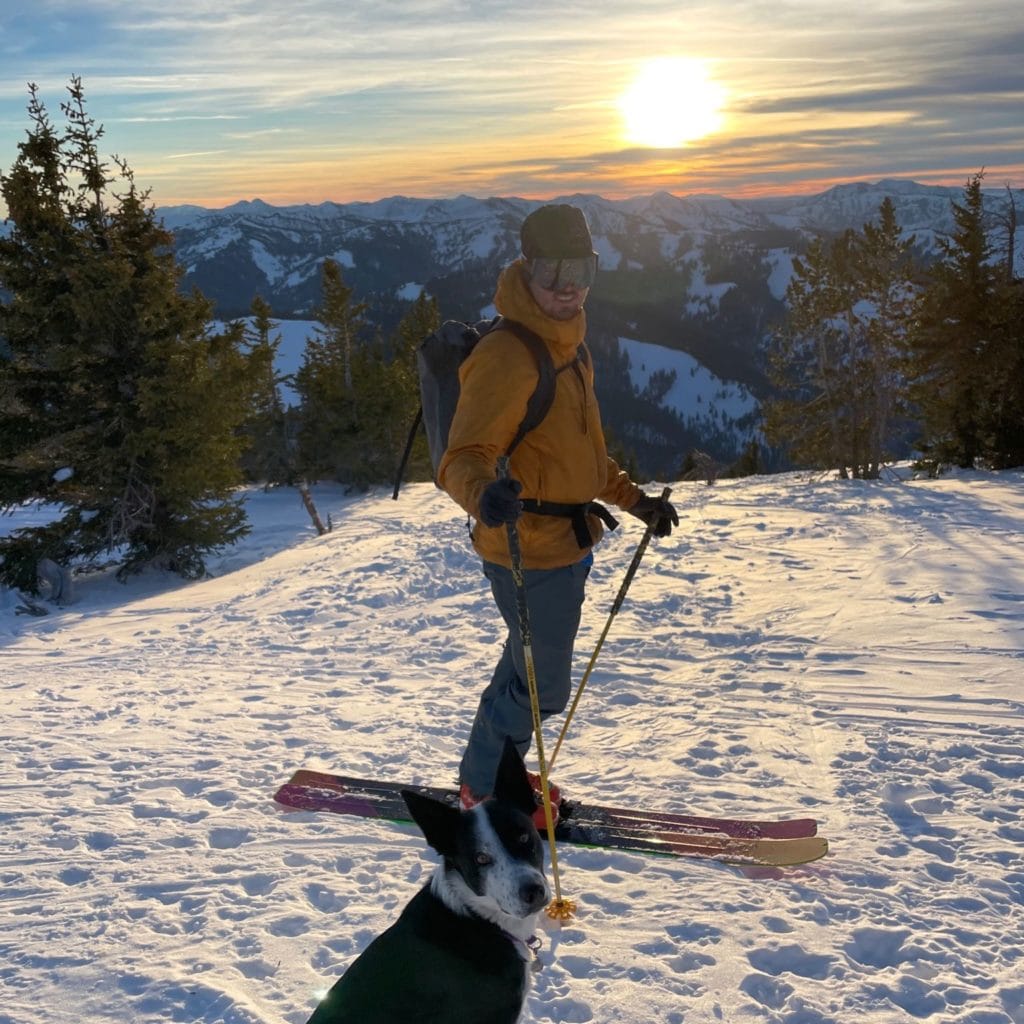
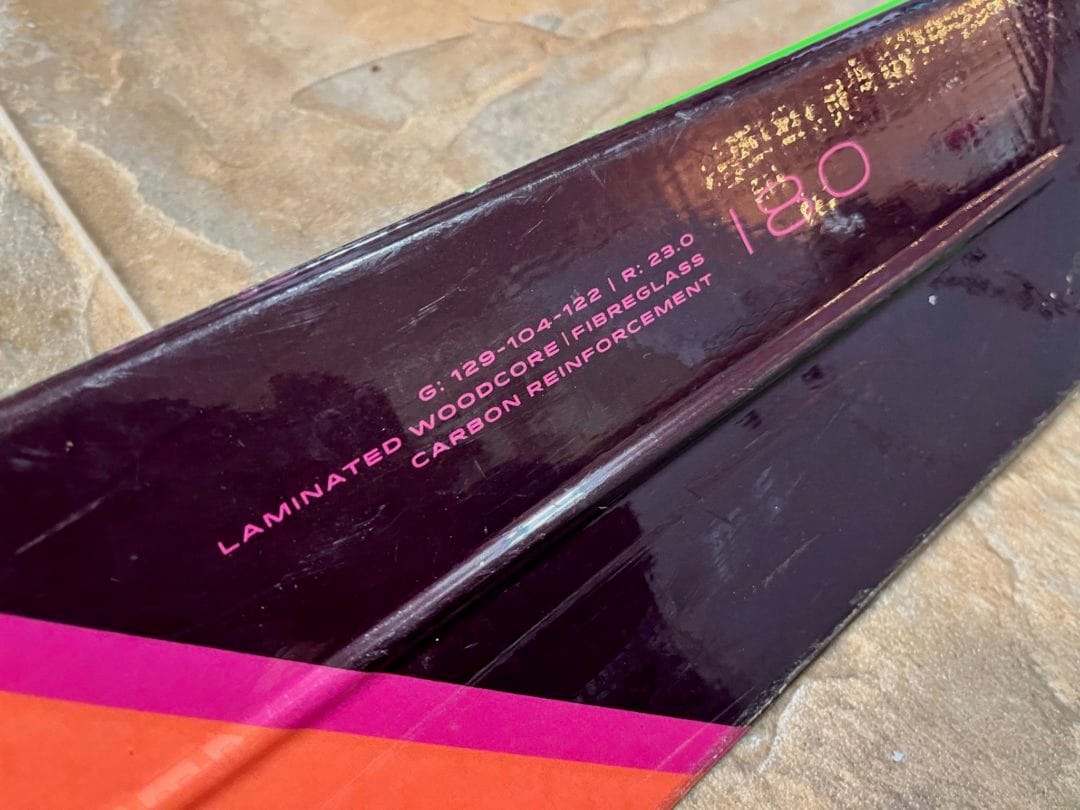






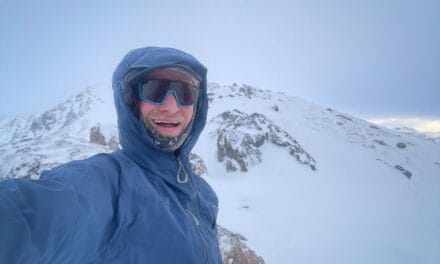
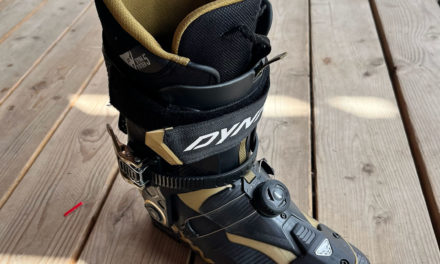
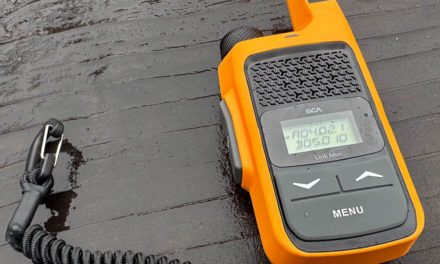

Thanks for the insightful review. Do you have any thoughts on how the lighter boots faired on them vs. the beefier ones?
Hey Travis, Generally speaking, I find skis with a more progressive mount, such as the RST 104, to get along well with lighter boots. I wouldn’t say there are many skis >90mm underfoot that ski better with a light/high ROM boot, relative to a beefy touring boot. The RST seemed in line with that generalization, and fared pretty well with the Zero G Peak.
Thanks, Gavin! Is that due to the need to use a more upright stance with lighter boots?